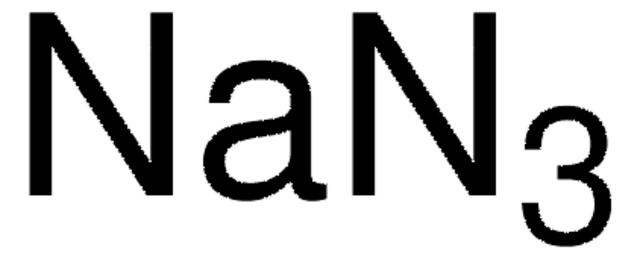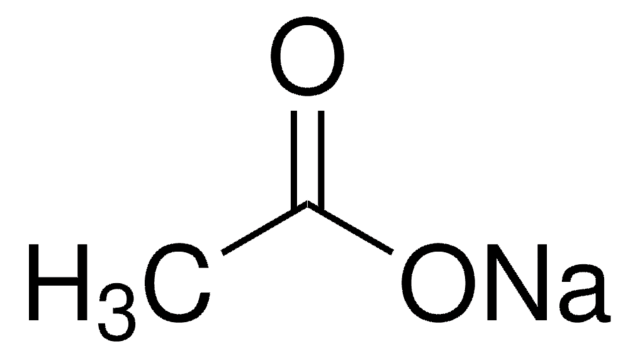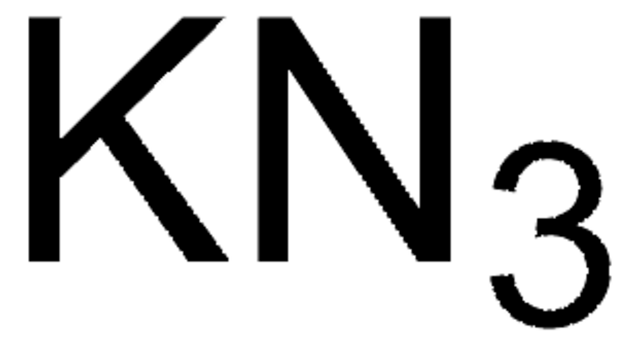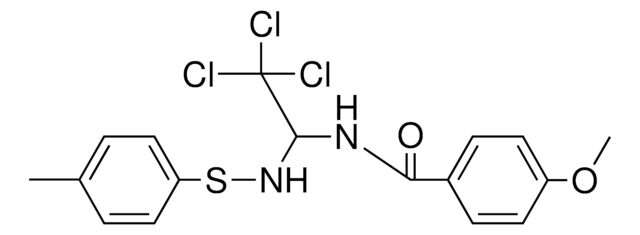S2002
Sodium azide
ReagentPlus®, ≥99.5%
Synonym(s):
Hydrazoic acid sodium salt
About This Item
Recommended Products
biological source
synthetic (inorganic)
Quality Level
product line
ReagentPlus®
assay
≥99.5%
form
powder
storage condition
(Tightly closed. Dry. Keep in a well-ventilated place. Do not store near acids.)
technique(s)
cell based assay: suitable
immunohistochemistry: suitable
color
white
mp
370-425 °C
solubility
soluble 65 g/L at 20 °C (completely)
suitability
suitable for chromatography
suitable for derivatization
application(s)
sample preparation
SMILES string
[Na]N=[N+]=[N-]
InChI
1S/N3.Na/c1-3-2;/q-1;+1
InChI key
PXIPVTKHYLBLMZ-UHFFFAOYSA-N
Looking for similar products? Visit Product Comparison Guide
General description
Application
Catalyst for:
- Oxidative decarboxylation
- Michael addition reactions
Reagent for synthesis of
- Blue fluorescent copolymers
- Metal phosphonates
- Arenes via aminations
Biochem/physiol Actions
Other Notes
Legal Information
comparable product
suggested gloves for splash protection
signalword
Danger
Hazard Classifications
Acute Tox. 1 Dermal - Acute Tox. 2 Inhalation - Acute Tox. 2 Oral - Aquatic Acute 1 - Aquatic Chronic 1 - STOT RE 2 Oral
target_organs
Brain
supp_hazards
wgk_germany
WGK 2
flash_point_f
Not applicable
flash_point_c
Not applicable
Choose from one of the most recent versions:
Certificates of Analysis (COA)
Sorry, we don't have COAs for this product available online at this time.
If you need assistance, please contact Customer Support.
Already Own This Product?
Find documentation for the products that you have recently purchased in the Document Library.
Customers Also Viewed
Protocols
Antibody Purification using Protein A, Protein G, or Protein L Agarose protocol is designed as a quick purification method for antibodies from mammalian sera, ascites, and cell culture supernatants. It should be noted that if the starting material is serum or ascites the final preparation will contain endogenous host IgG as well as specific antibodies. In general, the presence of this endogenous IgG should not interfere with assays using the antibodies.
ELISA protocols providing detailed instructions on performing indirect ELISA and Capture ELISA . Learn more about recommended products and techniques for performing both sandwich ELISA and indirect ELISA experiments.
Calibration Curves for TSKgel® SW mAb Columns
Our team of scientists has experience in all areas of research including Life Science, Material Science, Chemical Synthesis, Chromatography, Analytical and many others.
Contact Technical Service







